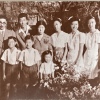Japanese overseas minister Namoru Shigemitsu indicators give up phrases as Allied officers look on Sept. 2, 1945 on USS Missouri moored in Tokyo Bay.
HUM Photographs/Getty Photographs
disguise caption
toggle caption
HUM Photographs/Getty Photographs
It was — fairly presumably — the worst day to make a mistake.
Sept. 2, 1945 was the day Japan formally surrendered to the Allies. It marked the official finish of World Conflict II.
The ceremony occurred on the deck of an American battleship, the united statesS. Missouri, moored in Tokyo Bay. A whole bunch of individuals crowded the deck to look at or take part within the momentous event.
Among the many signatories despatched by every of the key Allied powers was a comparatively low-ranking Canadian: Col. Lawrence Cosgrave, Canada’s protection attaché to Australia on the time.
Cosgrave was the best rating Canadian navy officer who may get to the ceremony in time, says Murray Brewster, a protection and overseas coverage correspondent for the Canadian Broadcasting Company.
“I’m pretty sure that he was in awe of standing among so many high-ranking officers. I mean, ones whose names go down in history,” Brewster lately advised NPR.
As soon as the Japanese delegation boarded the Missouri, the proceedings started. The 2 teams of signatories stood on reverse sides of a desk introduced from the battleship’s mess corridor. On the desk had been two copies of the instrument of give up: one for the Japanese and one for the Allies.
As soon as the Japanese representatives signed, it was time for the Allies to do the identical.
The method went easily till it got here time for Cosgrave to signal. When he sat all the way down to put pen to paper, Cosgrave ended up signing his identify on the mistaken line.

United States Military Gen. Douglas MacArthur reads his speech to open the give up ceremonies on board USS Missouri on Sept. 2, 1945. Allied representatives are behind him, together with Col. Lawrence Cosgrave.
U.S. Navy, Public area, through Wikimedia Commons
disguise caption
toggle caption
U.S. Navy, Public area, through Wikimedia Commons
“It had the potential at that moment of creating a bit of a diplomatic incident, because the Japanese, when they saw that not all of the signatures were in the appropriate place, suggested to General MacArthur’s chief of staff that they wouldn’t accept the document,” Brewster mentioned.
However the second handed. Somebody got here up with a repair and the Japanese finally relented.
The harm to Cosgrave’s legacy, although, was finished.
The New York Occasions famous Cosgrave’s dying in 1970 by writing that he “unintentionally delayed the conclusion of the armistice.”
That Cosgrave was remembered largely for his mistake did not appear proper to Brewster. He poured by way of the information that remained of Cosgrave’s life on the Canadian Conflict Museum and first wrote about his findings for Legion Journal.
Cosgrave was a veteran of World Conflict I and had misplaced an eye fixed a few years earlier than the give up ceremony.
“He went into the first World War all full of patriotic zeal and the slaughter that he witnessed in some of the major battles that took place … deeply traumatized him and deeply affected him,” Brewster mentioned.
After the warfare, he served as a diplomat in East Asia. He traveled extensively in Tokyo and different Japanese cities throughout that point — cities he would later return to in 1945.
“Yokohama is the city of the dead, the dreadful effect of modern firebombing fusing glass, iron and household items into complete nothingness,” Cosgrave wrote to a pal across the time of the give up after witnessing the consequences of Allied firebombing, in response to Brewster.
Brewster says that Cosgrave was “probably overwhelmed … at the time of the signing because of the company he was in.” He was surrounded by officers made well-known by years of warfare.
Cosgrave’s story additionally comes with a lesson: do not be so fast to guage, Brewster says.
“We live in an age right now where there are instantaneous judgments about people and about their character,” he says. “(Cosgrave is) known to history as the man who signed on the wrong line. But his life was so much more than that.”






